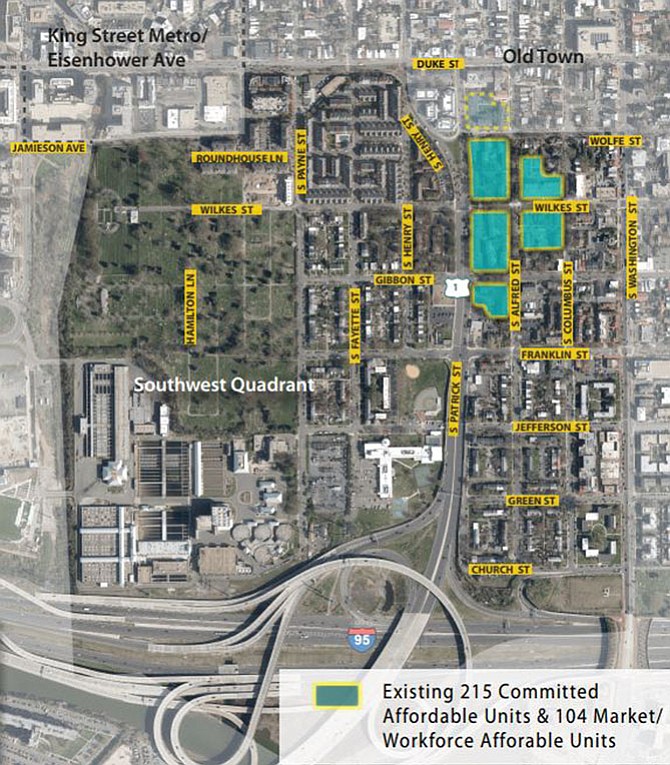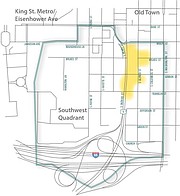Route 1 South has been an affordable part of Alexandria for over a century. It was one of the predominantly black neighborhoods that arose out of the Civil War era to shelter former slaves seeking refuge in the north, who bonded together in Alexandria to form a community. Then during urban renewal, it was redeveloped to include workforce housing and affordable apartments. Now, as prices continue to rise for homes in Alexandria, the city is working to stave off market demands for luxury homes and save one of Alexandria’s historically affordable neighborhoods.
“Within the area that is the primary focus of this update to the plan we have three properties that have been deeply affordable for a very long time because they have had these Housing and Urban Development (HUD) rental subsidies,” said Helen McIlvaine, director of the Office of Housing.
According to McIlvaine, the properties were all at one point owned by a national company, AIMCO, and were sold in 2009. One set of homes is owned by the Alfred Street Baptist Church, the other by a New York real estate investment company called Ares. McIlvaine says the ones owned by Ares, called The Heritage and Old Towne West III, could not renew that contract with one year of notice.
Between the two sites, there are 215 committed affordable housing units. There are 140 committed affordable units at Heritage and 104 market affordable units. At Olde Towne West III there are 75 committed affordable units. Heritage’s rental subsidies from HUD are renewed on an annual basis, and the rental subsidy contract on Olde Towne West III expires in late 2019. Many of these units are family sized, which is in high demand for affordable housing in Alexandria.
“It’s in the general neighborhood where other housing is very expensive,” said McIlvaine. “Without something like this, there are very few ways to put the breaks on housing costs.”
Redevelopment of the homes along Route 1 South is inevitable, but city staff say the battle now is working to keep housing affordability part of the redevelopment.
“There is an acknowledgement that some of these will develop over time,” said Jeff Farner, deputy director of Planning and Zoning. “This is a chance to be proactive and establish vision for corridor. Part of this plan is to be proactive and make sure whatever we come up with sort of reinforces the character of the corridor.”
Farner said identifying the character of the corridor is one of the main focuses of the ongoing community meetings. Throughout January, a series of pop-up meetings took place throughout the neighborhood and surrounding locations. Two community meetings will be held in February, one on Feb. 15 from 7 to 9 p.m. at a location to be determined, and one on Feb. 20, from 7 to 9 p.m. at the Lee Center. Monday, Feb. 26 through Saturday, March 3, a charrette will be held at the Lee Center Exhibit Hall, hosting evening community meetings and promoting engagement with staff. By the week of April 16, a draft plan will be released for public hearings at the Planning Commission and City Council in June.
Meanwhile, to the west, Alfred Street Baptist Church is undergoing expansion. The contract on the Alfred Street Baptist Church affordable properties is set to expire in 2019-2020. Two townhomes with 22 units of affordable housing will be demolished as part of the expansion plans, with residents relocated to properties owned by the Alexandria Housing Development Corporation. There are 55 other committed affordable units owned by Alfred Street Baptist Church in the surrounding neighborhood.
“We are hopeful that we will come up with a plan to potentially help incentivize them to renew their contracts on a long-term basis and provide ways to either preserve or redevelop them,” said Farner.
“We’re lucky that Alfred Street has fully embraced the planning process,” said McIlvaine. “I think our goals are aligned, that we are all interested in preserving the housing affordability. Among the things we have talked to them about, we’re working together to preserve those contracts over the long term. That’s part of what this planning process is about: what tools and strategies can we use to keep all of the units affordable. They are due to expire beginning next year, which is one of the reasons that the planning process is time sensitive.”
Over the last year, Alfred Street Baptist Church has been working on and slowly moving forward with plans for construction. McIlvaine says a memorandum of understanding is being developed between the city and the church that the 22 units being lost as part of the construction will eventually be replaced.
“That could be part of the redevelopment of the other 55 units, or could buy a building nearby,” said McIlvaine, “but we want these to be units we’re not currently counting.”
For the remaining 55 units, McIlvaine said the planning process is still in the earliest stages, and it’s unclear whether they will be renovated and refinanced or whether they will be redeveloped as a mix of affordable and market rate. But with the contracts expiring next year, McIlvaine said it’s critical to begin the planning for that sooner rather than later.
“This has been on our radar for a while,” said McIlvaine. “We want to be at a point where we have dates and a real plan.”
As for the church redevelopment, Rob Kerns, division chief for Planning and Zoning, says the church has been in discussions with the city about the expansion for two years.
“It’s a large endeavor, and they’ve been working with the community through various meetings and revisions,” said Kerns. “They’ve been working around making changes based on neighborhood and staff feedback, and bringing along their congregation which ultimately has to pay for this project. The Board of Architectural Review comments recently subtly adjusted the building to again be more friendly to the historic district and neighbors, as well as working with underground parking garage. They’re having technical studies done there because have to be careful about underground water situation. They’re getting into the fine detail for viability and cost.”
Kerns said the project is expected to come to a public hearing this fall.
“They have not been in a rush for this project,” said Kerns. “They’re pacing along to try and do it correctly, bringing neighbors and parishioners along. They were originally looking at spring, but moved to fall to make sure everything is in order.”

